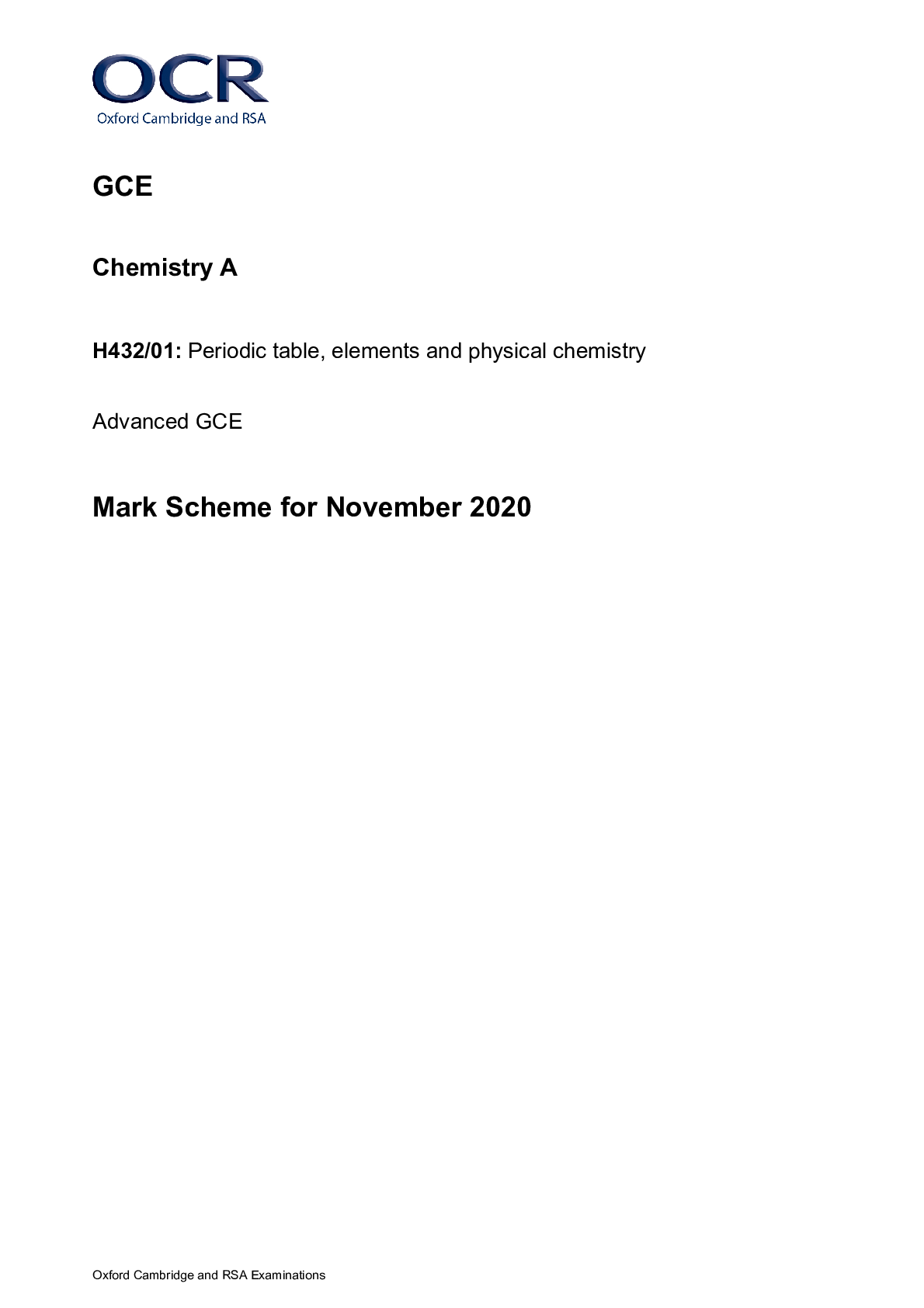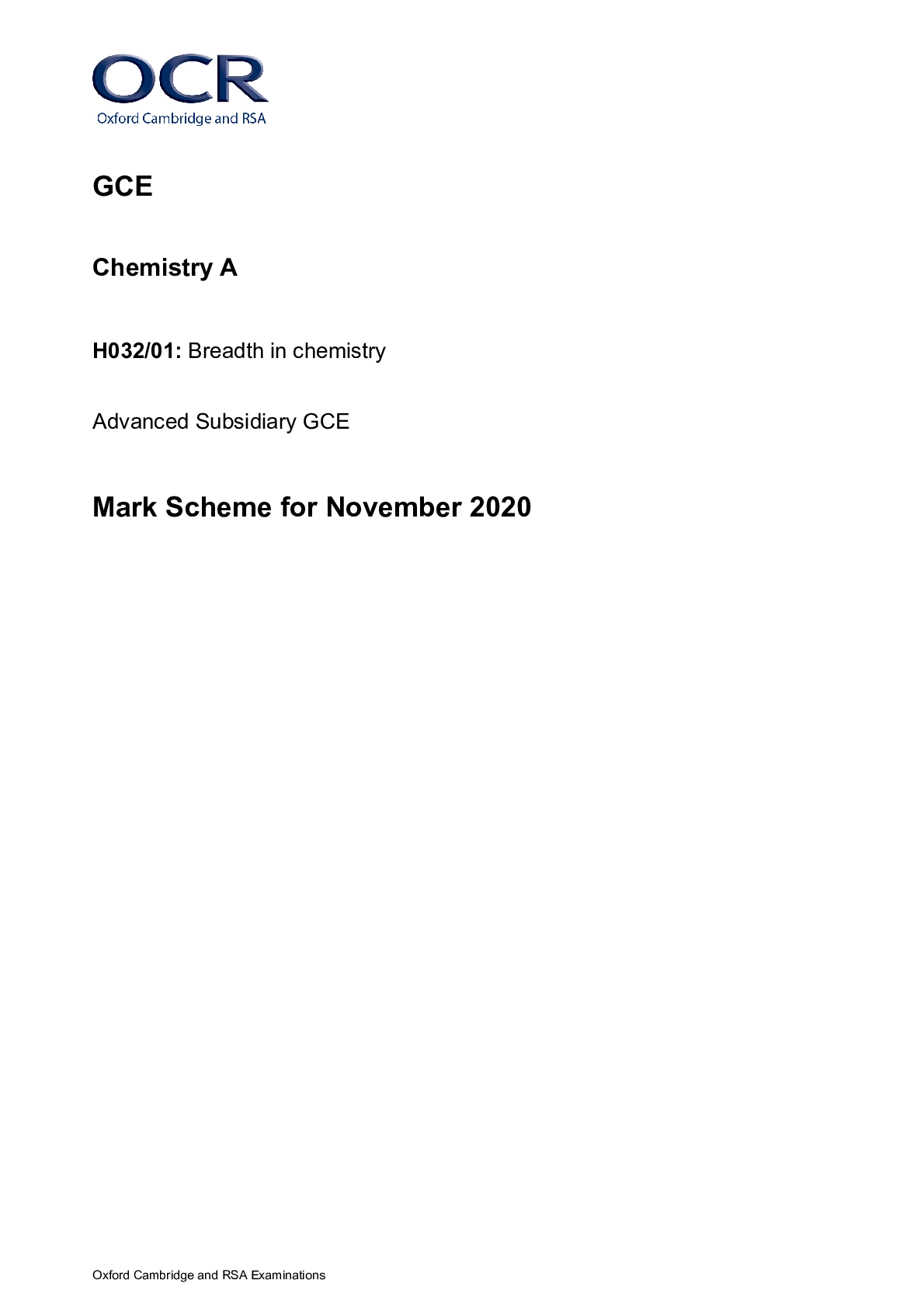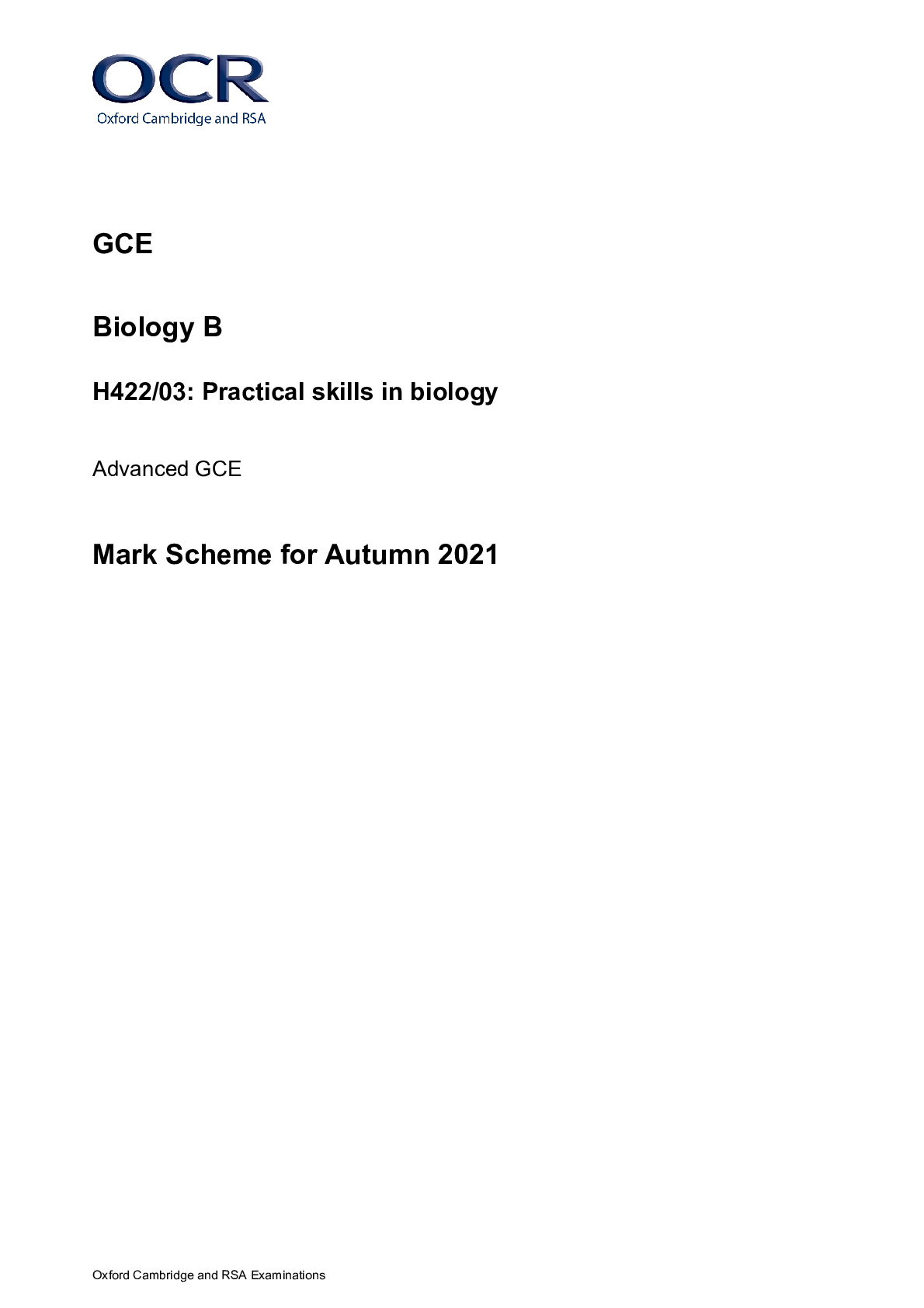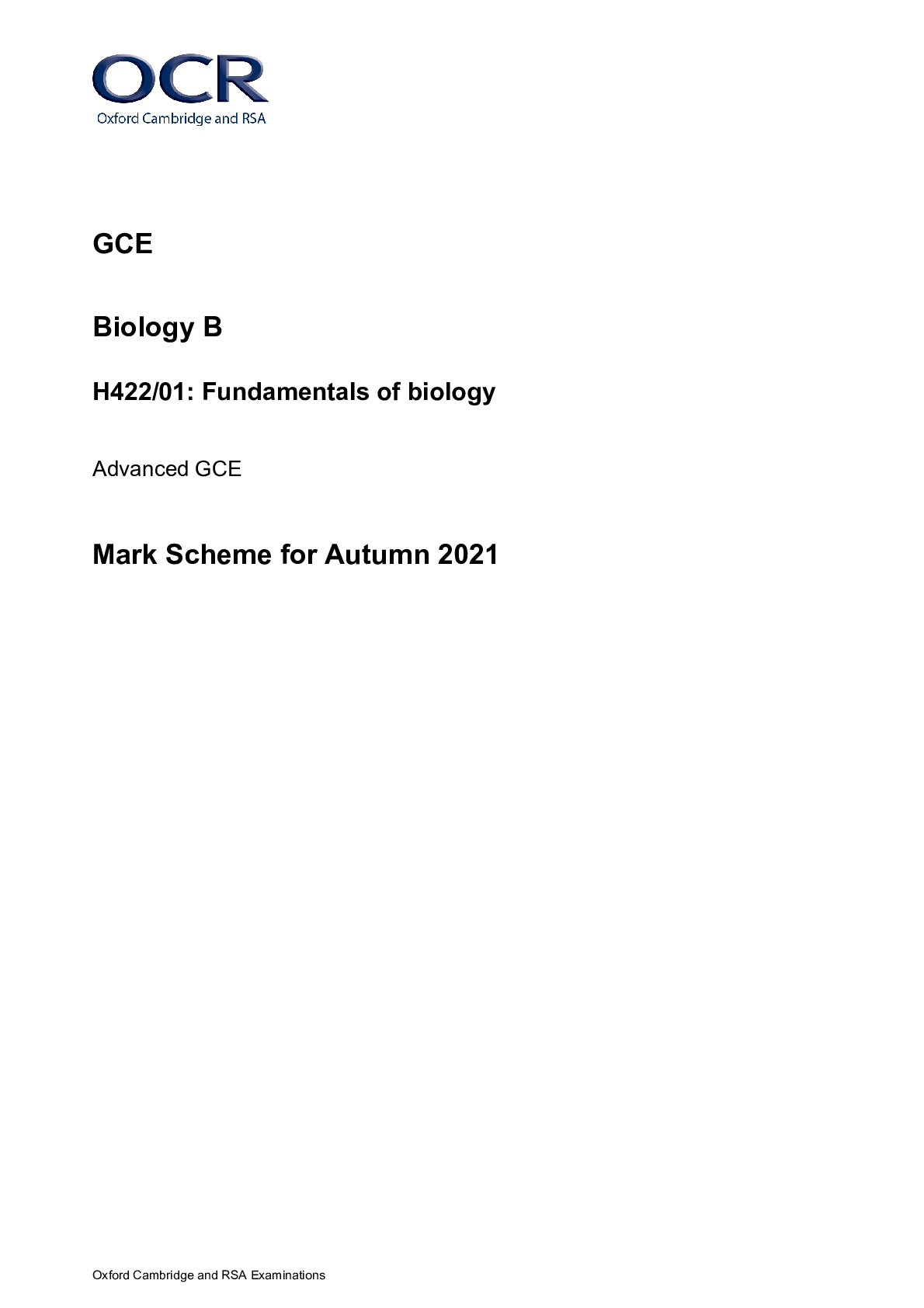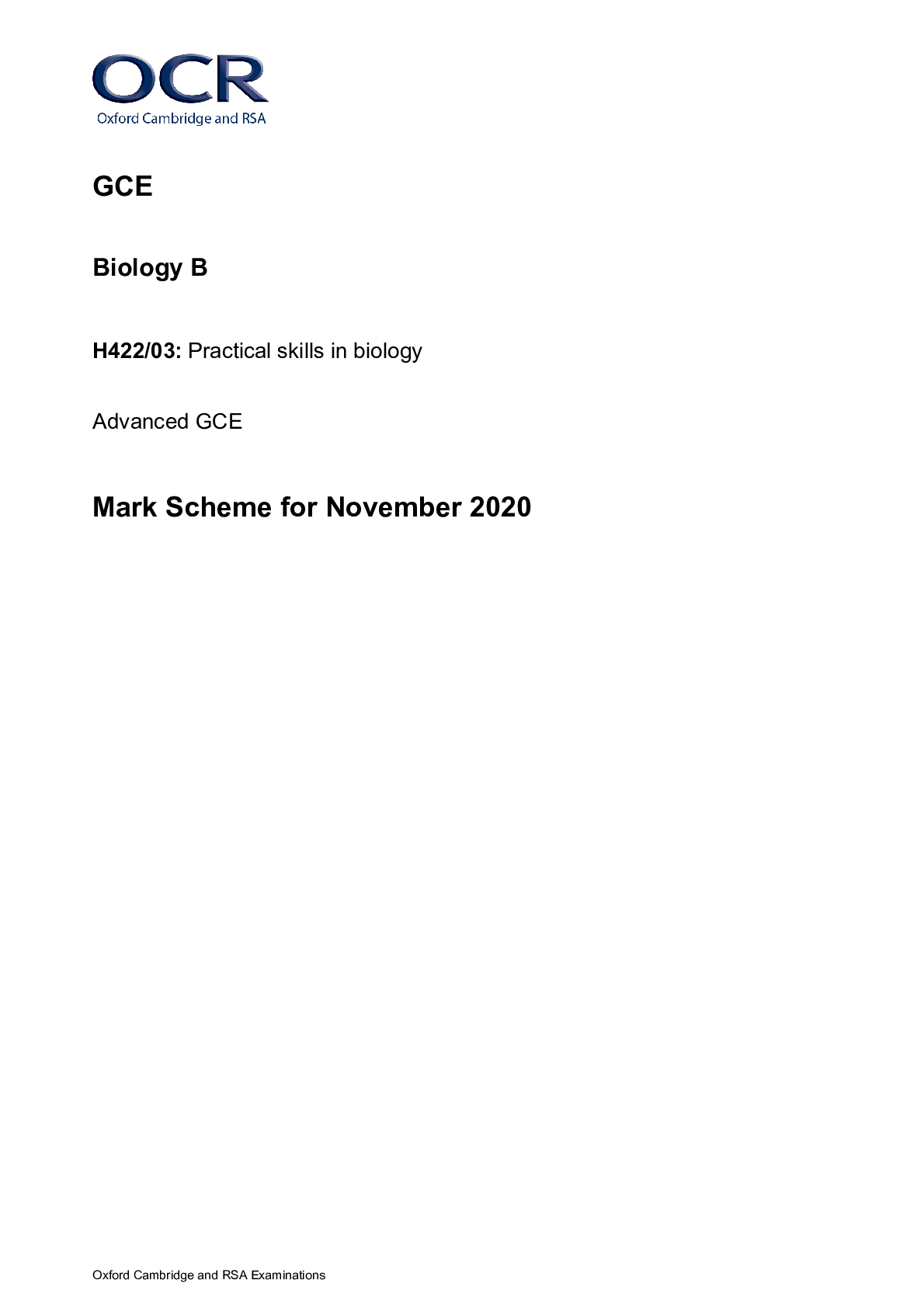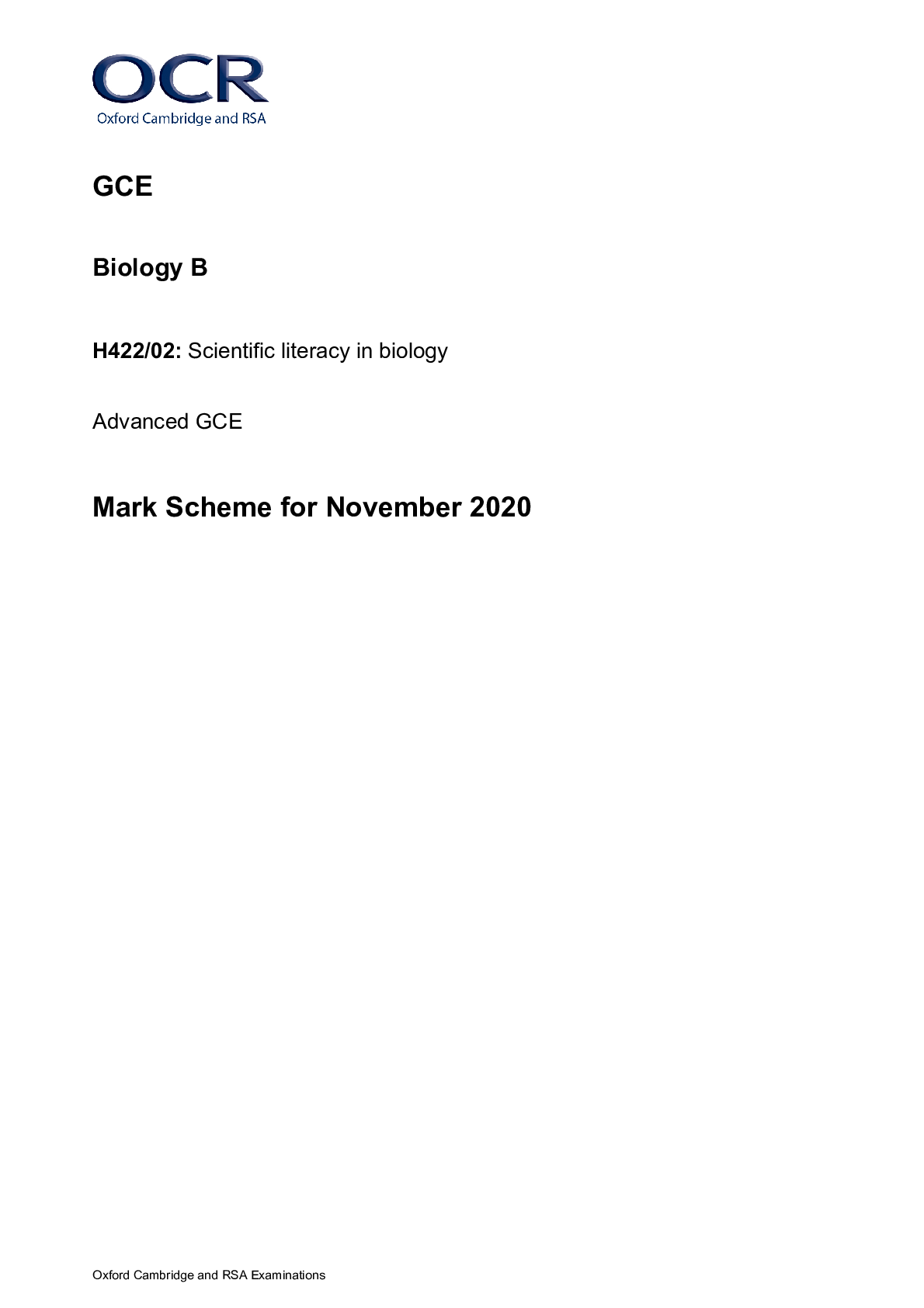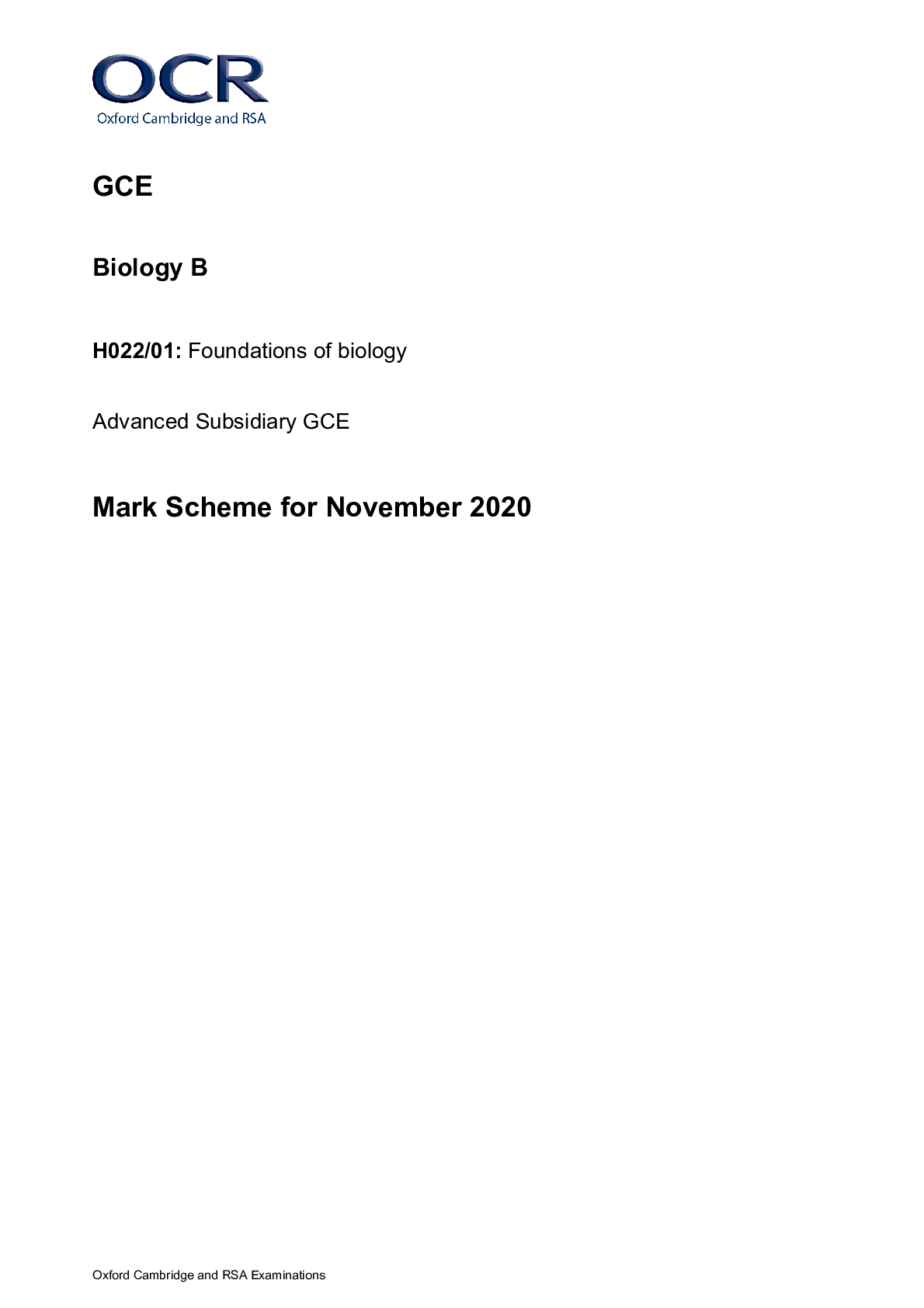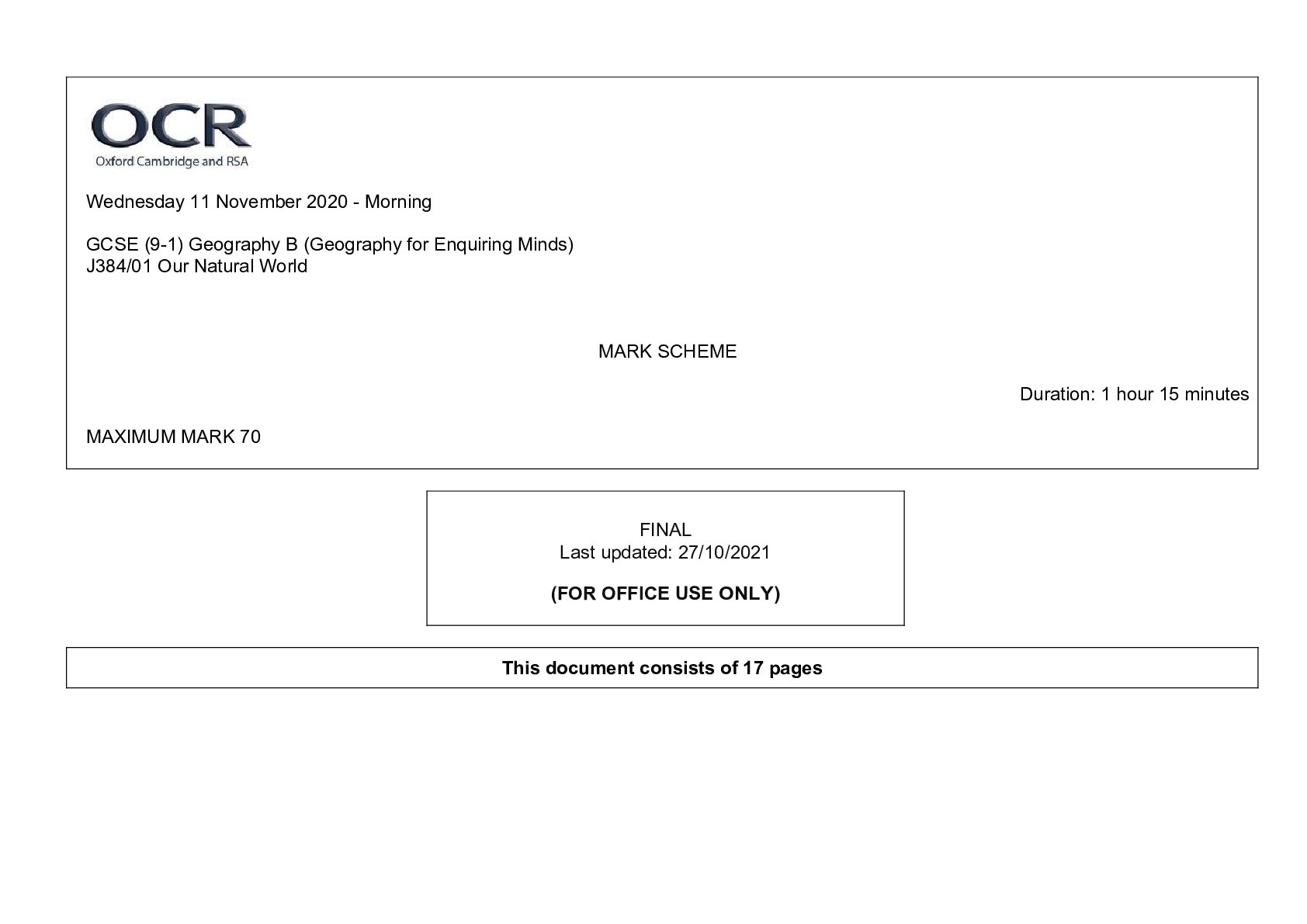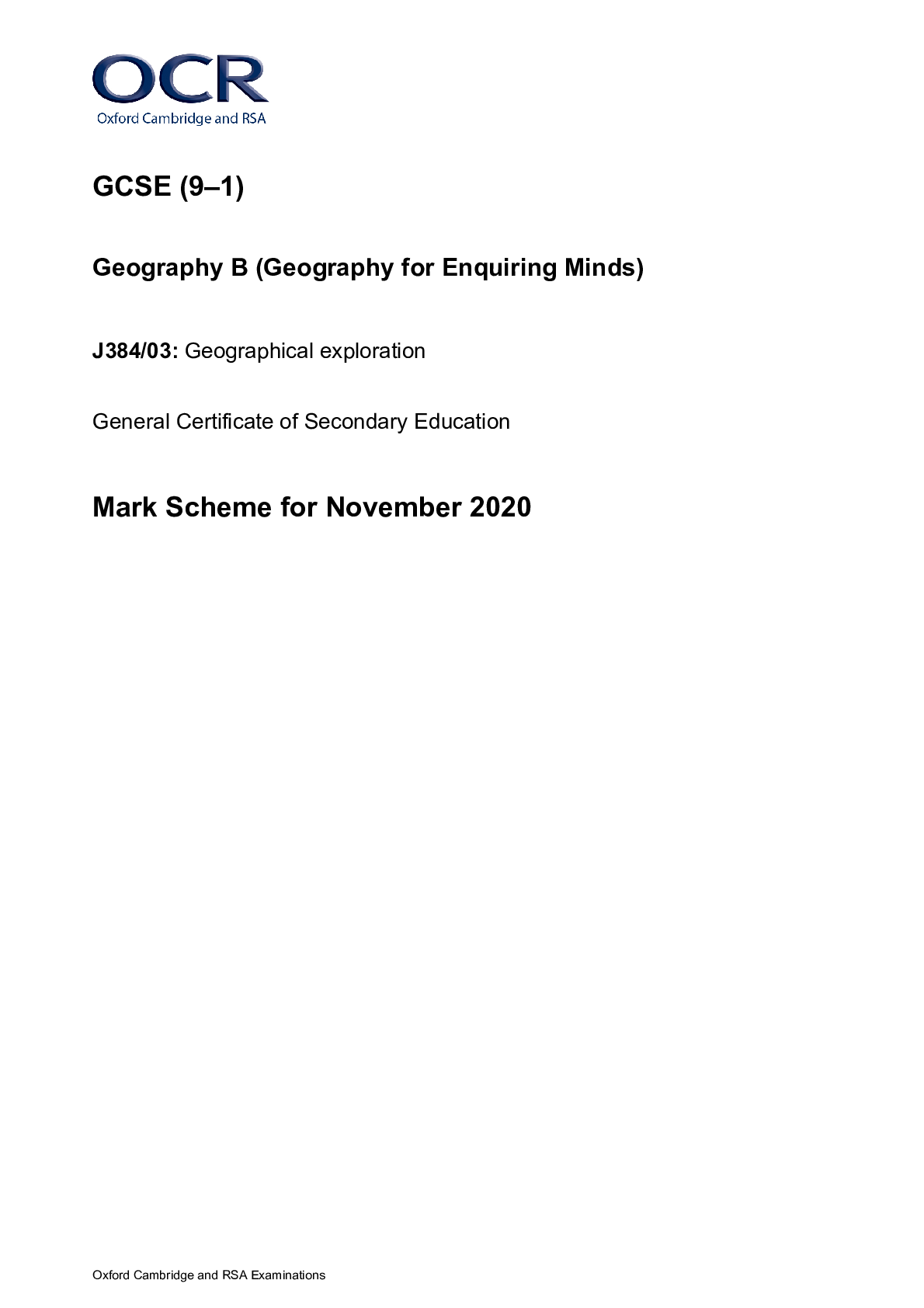Geography > GCSE MARK SCHEME > GCSE (9-1) Geography B (Geography for Enquiring Minds) J384/02 People and Society MARK SCHEME (All)
GCSE (9-1) Geography B (Geography for Enquiring Minds) J384/02 People and Society MARK SCHEME
Document Content and Description Below
GCSE (9-1) Geography B (Geography for Enquiring Minds) J384/02 People and Society MARK SCHEME Tuesday 16 November 2020 – Morning GCSE (9-1) Geography B (Geography for Enquiring Minds) J384/... 02 People and Society MARK SCHEME Duration: 1 hour 15 minutes MAXIMUM MARK 70 Version: Post Standardisation Last updated: 27/10/2021 (FOR OFFICE USE ONLY) This document consists of 16 pagesJ384/02 Mark Scheme November 2020 2 Annotations Annotation Meaning Blank page – the annotation must be used on all blank pages within an answer booklet (structured or unstructured) and on each page of an additional object where there is no candidate response Correct response Incorrect response Unclear Information omitted Level 1 Level 2 Level 3 Level 4 Development Relevant place detail Benefit of doubt Significant amount of material which doesn’t answer the question Expandable vertical wavy line Communicate findings Noted but no credit givenJ384/02 Mark Scheme November 2020 3 Subject Specific Marking Instructions INTRODUCTION Your first task as an Examiner is to become thoroughly familiar with the material on which the examination depends. This material includes: • the specification, especially the assessment objectives • the question paper and its rubrics • the mark scheme. You should ensure that you have copies of these materials. You should ensure also that you are familiar with the administrative procedures related to the marking process. These are set out in the OCR booklet Instructions for Examiners. If you are examining for the first time, please read carefully Appendix 5 Introduction to Script Marking: Notes for New Examiners. Please ask for help or guidance whenever you need it. Your first point of contact is your Team Leader. USING THE MARK SCHEME Please study this Mark Scheme carefully. The Mark Scheme is an integral part of the process that begins with the setting of the question paper and ends with the awarding of grades. Question papers and Mark Schemes are developed in association with each other so that issues of differentiation and positive achievement can be addressed from the very start. This Mark Scheme is a working document; it is not exhaustive; it does not provide ‘correct’ answers. The Mark Scheme can only provide ‘best guesses’ about how the question will work out, and it is subject to revision after we have looked at a wide range of scripts. Please read carefully all the scripts in your allocation and make every effort to look positively for achievement throughout the ability range. Always be prepared to use the full range of marks.J384/02 Mark Scheme November 2020 4 LEVELS OF RESPONSE QUESTIONS: The indicative content indicates the expected parameters for candidates’ answers, but be prepared to recognise and credit unexpected approaches where they show relevance. Using ‘best-fit’, decide first which set of level descriptors best describes the overall quality of the answer. Once the level is located, adjust the mark concentrating on features of the answer which make it stronger or weaker following the guidelines for refinement. Highest mark: If clear evidence of all the qualities in the level descriptors is shown, the HIGHEST Mark should be awarded. Lowest mark: If the answer shows the candidate to be borderline (i.e. they have achieved all the qualities of the levels below and show limited evidence of meeting the criteria of the level in question) the LOWEST mark should be awarded. Middle mark: This mark should be used for candidates who are secure in the level. They are not ‘borderline’ but they have only achieved some of the qualities in the level descriptors. Be prepared to use the full range of marks. Do not reserve (e.g.) highest level marks ‘in case’ something turns up of a quality you have not yet seen. If an answer gives clear evidence of the qualities described in the level descriptors, reward appropriately.J384/02 Mark Scheme November 2020 5 AO1 AO2 AO3 Comprehensive A range of detailed and accurate knowledge that is fully relevant to the question. A range of detailed and accurate understanding that is fully relevant to the question. Detailed and accurate interpretation through the application of relevant knowledge and understanding. Detailed and accurate analysis through the application of relevant knowledge and understanding. Detailed and substantiated evaluation through the application of relevant knowledge and understanding. Detailed and substantiated judgement through the application of relevant knowledge and understanding. Thorough A range of accurate knowledge that is relevant to the question. A range of accurate understanding that is relevant to the question. Accurate interpretation through the application of relevant knowledge and understanding. Accurate analysis through the application of relevant knowledge and understanding. Supported evaluation through the application of relevant knowledge and understanding. Supported judgement through the application of relevant knowledge and understanding. Reasonable Some knowledge that is relevant to the question. Some understanding that is relevant to the question. Some accuracy in interpretation through the application of some relevant knowledge and understanding. Some accuracy in analysis through the application of some relevant knowledge and understanding. Partially supported evaluation through the application of some relevant knowledge and understanding. Partially supported judgement through the application of some relevant knowledge and understanding. Basic Limited knowledge that is relevant to the topic or question. Limited understanding that is relevant to the topic or question. Limited accuracy in interpretation through lack of application of relevant knowledge and understanding. Limited accuracy in analysis through lack of application of relevant knowledge and understanding. Un-supported evaluation through lack of application of knowledge and understanding. Un-supported judgement through lack of application of knowledge and understanding.J384/02 Mark Scheme November 2020 6 Question Answer Mark Guidance 1 (a) C: A city which is very important in the global economy () 1 () (b) ((20-24)/20) x 100 () or ((24-20)/20) x 100 () 20% () 2 1 x 1 () for correct answer 1 x 1 () for appropriate working out (c) There is a Chinese arch / restaurants / supermarkets () There is Chinese language / symbols on signage () There are Chinese people of different ethnicities () 1 1 x 1 () for valid evidence visible in Fig. 1 which suggests that migration has had an impact on this city (d) In some cities, the majority of migrants are young people (). As they are looking for employment this can cause a growth in the informal sector in jobs (). Young families can put increase pressure on schools and healthcare () Migration increases diversity in cities () as there are more people (). Migrants bring their own culture to the city (). Migration can increase the size of a city as more people move there (). This may lead to overcrowding/ overpopulation () Many migrants cannot afford to buy a house which results in shanty housing being built (). 3 3 x 1 () for explanation of how migration changes the growth and character of cities Development awarded with () as a further valid explanation Answer can refer to AC and/or LIDC cities. 1 mark reserve for growth / character (e) Case Study: contemporary challenge in LIDC or EDC. Level 3 (5-6 marks) An answer at this level demonstrates thorough knowledge of one contemporary challenge in an LIDC or EDC city (AO1) with a thorough evaluation of the impacts on everyday life in the city (AO3). This will be shown by including well-developed ideas about the challenge and its impacts. 6 Case study will be marked using 3 levels: Indicative Content Named LIDC or EDC city can be in any country as defined by the IMF. Evaluation of contemporary challenge may be speculative but must be based on evidence. Example of well-developed ideas:J384/02 Mark Scheme November 2020 7 The answer must also include place-specific details for the named LIDC or EDC city. Level 2 (3-4 marks) An answer at this level demonstrates reasonable knowledge of one contemporary challenge in an LIDC or EDC city (AO1) with a reasonable evaluation of the impacts on everyday life in the city (AO3). This will be shown by including developed ideas about the challenge and its impacts. Developed ideas but no place-specific details credited up to bottom of level. Level 1 (1-2 marks) An answer at this level demonstrates basic knowledge of one contemporary challenge in an LIDC or EDC city (AO1) with a basic evaluation of the impacts on everyday life in the city (AO3). This will be shown by including simple ideas about the challenge and its impacts. Named examples only receives no place specific detail credit. 0 marks No response worthy of credit. Istanbul is one of the most congested cities in the world. At peak commuting times, people can only drive at speeds of 8-10km per hour and commuters spend an average of two hours per day sat in traffic congestion, making their working day longer. This is particularly bad in the Bosphorus area of Istanbul. It has led to lower air quality in the city and has resulted in an increase in the amount of people with asthma, chronic lung conditions and even lung cancer. There has been a 60% increase in some lung disease in the last 20 years leaving some people unable to carry out their normal exercise routine, or even walk. Example of developed ideas: Istanbul in Turkey has bad traffic congestion. People sit in queues for an average of two hours per day when they are travelling to work, which has a negative impact on them as it is wasting their time. More people are also suffering with conditions like lung cancer and asthma because of the poor air quality. This has an impact on their lives and also their families as they may need to help to look after them. Example of simple ideas: Istanbul has bad traffic queues which wastes time. People are getting ill because the air quality is not very good because of all of the cars. AC cities / whole countries or no named example credit at L2 – 3 max.J384/02 Mark Scheme November 2020 8 Question Answer Mark Guidance 2 (a) D: When there is an improvement in living standards in a country () 1 () (b) (i) Overall, the GNI per capita of Mozambique has increased () but it has started to decline since 2014 () (C). The GNI per capita of Mozambique was at its lowest in 1994/1995 () after that date it generally increased to in excess of $600 in 2014 () (C). 3 2 x 1 () for appropriate descriptions 1 x 1 (C) for communicating the answer in an appropriate and logical order, this is most typically demonstrated in a chronological order. (ii) It will have had a positive impact as more children will be able to go to school (). The healthcare in the country is likely to have improved (). Sanitation will be better () Now the GNI is going down there may be food insecurity (). 1 1 x 1 () for appropriate suggestion of how a change in GNI per capita may have impacted the people of Mozambique No credit for single word response No credit for generic statements (iii) Many people may live in rural areas () which means that it is hard for them to get to school to get an education (DEV). The government may be corrupt () and may not spend money wisely on things to benefit poorer people (DEV). The country may not have many natural resources () so they cannot make enough money from trade (DEV). The country may have a hot, dry climate which limits water supply () and makes farming difficult creating food insecurity (DEV). 2 1 x 1 () for reason why it may be hard for countries like Mozambique to break out of poverty. Credit for human or physical factors. 1 x 1 (DEV) for explanation. (c) Case Study: Trade and aid in an LIDC Level 3 (5-6 marks) An answer at this level demonstrates thorough knowledge of the LIDC international trade (AO1) with thorough understanding of how international trade has influenced the LIDC’s development (AO2). This will be shown by including well-developed ideas about international trade and the influence on the LIDC’s development. Level 2 (3-4 marks) An answer at this level demonstrates reasonable knowledge of the LIDC international trade (AO1) with reasonable understanding of 6 Case study will be marked using 3 levels: Indicative Content Named LIDC country can be any as defined by the IMF. Explanation may explain the influence of trade and/or TNCs on development of the country. Example of well-developed ideas: The ABF (Association of British Foods) is a TNC which operates in Zambia. Zambia Sugar is part of this company and runs sugar plantations in Mazabuka. It has provided jobs for some Zambians, although many of the higher paid jobs are overseas. This brings someJ384/02 Mark Scheme November 2020 9 how international trade has influenced the LIDC’s development (AO2). This will be shown by including developed ideas about international trade and the influence on the LIDC’s development. Level 1 (1-2 marks) An answer at this level demonstrates basic knowledge of the LIDC international trade (AO1) with basic understanding of how international trade has influenced the LIDC’s development (AO2). This will be shown by including simple ideas about international trade and the influence on the LIDC’s development. 0 marks No response worthy of credit. money into the country as people who earn money have to pay taxes. However, Zambia offers tax breaks to TNCs to encourage investment in the country. This means the government does not get as much money as they could. Example of developed ideas: TNCs are encouraged to invest in Zambia, but they are offered reduced levels of tax to encourage them to work in the country. This means that Zambia does not make as much money as they could. Example of simple ideas: TNCs have invested in Zambia but it was not always a good deal for the country. AC or EDC named example credit at L2 – 3 max.J384/02 Mark Scheme November 2020 10 Question Answer Mark Guidance 3 (a) The population of the UK has increased (). There are more people in the 45-49 age group (). There are more people in the 0-4 age group (). There are more people living over 80 (). 1 1x 1 () for correctly identifying a change in the population of the UK between 2005 and 2015. Credit for specific references from Fig. 3 No credit for non-specific groups of people e.g. children (b) B: 3882949() 1 () (c) The birth rate is relatively low () as more women go to work () and bringing up children is expensive () There are more people living to an old age () because there is better healthcare () and more illnesses can be treated (). 3 3 x 1 () for valid explanation of why the UK is in the fourth stage of the Demographic Transition Model. Allow development of ideas. 1 mark max for a description of the characteristics of a stage 4 population pyramid. (d) Level 3 (6-8 marks) An answer at this level demonstrates thorough understanding of how the UK is dealing with an ageing population (AO2). There will be with a reasonable evaluation of whether the UK is dealing with its ageing population effectively (AO3) to come to a thorough judgement of the extent to which the statement is agreed with. (AO3). This will be shown by including well-developed ideas about ageing populations and how the UK is dealing with its ageing population. There is a well-developed line of reasoning which is clear and logically structured. The information presented is relevant and substantiated. Level 2 (3-5 marks) An answer at this level demonstrates reasonable understanding of how the UK is dealing with an ageing population (AO2). There will be with a basic evaluation of whether the UK is dealing with its ageing population effectively (AO3) to come to a reasonable judgement of the extent to which the statement is agreed with. (AO3). 8 This question will be marked using 3 levels: Indicative Content Response will include detail about how the UK is dealing with its ageing population and a judgement will be made as to whether it is dealing with it effectively or not. Example of well-developed ideas. The UK is dealing with its ageing population quite well. It has raised the retirement age to 65 so that people are working for longer and are therefore paying taxes to the government rather than claiming a pension, so this costs the UK less money. By 2046, this will have raised to 68 in response to people living longer. Older people are also encouraged to exercise and remain active. This helps them to keep well and therefore reduces the need for them to access the NHS for medical care. Despite this, the spending of the NHS on retired households is still double that of other households. As the ageing population gets bigger, the government will have to find more money to support the healthcare system.J384/02 Mark Scheme November 2020 11 This will be shown by including developed ideas about ageing populations and how the UK is dealing with its ageing population. There is a line of reasoning presented with some structure. The information presented is in the most-part relevant and supported by some evidence. Level 1 (1-2 marks) An answer at this level demonstrates basic understanding of how the UK is dealing with an ageing population (AO2). There may be a basic evaluation of whether the UK is dealing with its ageing population effectively (AO3) or a basic judgement of the extent to which the statement is agreed with. (AO3). This will be shown by including simple ideas about ageing populations and the associated benefits and/or problems for the UK. The information is basic and communicated in an unstructured way. The information is supported by limited evidence and the relationship to the question may not be clear. 0 marks No response worthy of credit. Example of developed ideas. In the UK the retirement age has already been increased to 65 and is set to increase to 68. This shows the UK is dealing with their ageing population successfully as people will not be claiming pensions if they are working longer. However, we will need to build more care homes and this will be very expensive. Example of simple ideas. The ageing population in the UK is not being dealt with very well because old people get ill a lot and their medical care is expensive.J384/02 Mark Scheme November 2020 12 Question Answer Mark Guidance 4 (a) A: When all people always have access to sufficient, safe and nutritious food () 1 () (b) Population is increasing () which means that more water is needed for agriculture to provide food (DEV). As countries develop and there is often more industry (). Many processes need water, for example for cooling in electricity generation (DEV). Climate change can reduce rainfall () This results in less drinking water being available (DEV). 2 1 x 1 () for valid factor leading to demand outstripping supply for water 1 x 1 (DEV) for explanation (c) (i) Add horizontal lines so easier to read () Have uniform spacing between bars () Group countries by IMF category () Have more intervals for number of calories so easier to see differences () 1 1 x 1 () for appropriate improvement to the graph suggested (ii) (3641+3413+3540+2458+1695+1318) = 16065 () 16065/6 () 2677.5 () 3 1 x 1 () for correct answer 2 x 1 () for appropriate working out shown. 1 mark for adding 6 amounts (16,065) 1 mark for dividing by 6. (d) Case study: Food security Level 3 (5-6 marks) An answer at this level demonstrates thorough knowledge of the success of one attempt to achieve food security at a local scale (AO1) with a thorough analysis of the success of the attempt to achieve food security at a local scale (AO3). This will be shown by including well-developed ideas about the success of one attempt to achieve food security at a local scale. The answer must also include place-specific details for the local scale food security attempt. Level 2 (3-4 marks) 6 Case study will be marked using 3 levels: Indicative Content Response will include detail about a small scale, bottom up attempt to increase food security and a judgement will be made as to whether it has been successful or not. Answer can be from an LIDC or AC. Example of well-developed ideas. Urban gardens are a bottom up approach to food security. In some cities in LIDCs people are being taught how to use any available space to go grow food that they would not otherwise be able to afford to buy. In Kibera in Nairobi, there are community gardens in 16 villages in the slum area where peopleJ384/02 Mark Scheme November 2020 13 An answer at this level demonstrates reasonable knowledge of the success of one attempt to achieve food security at a local scale (AO1) with a reasonable analysis of the success of the attempt to achieve food security at a local scale (AO3). This will be shown by including developed ideas about the success of one attempt to achieve food security at a local scale. Developed ideas but no place-specific details credited up to bottom of level. Level 1 (1-2 marks) An answer at this level demonstrates basic knowledge of the success of one attempt to achieve food security at a local scale (AO1) with a basic analysis of the success of the attempt to achieve food security at a local scale (AO3). This will be shown by including simple ideas about the success of one attempt to achieve food security at a local scale. Simple ideas or appropriate named example only credited at the bottom of the level. 0 marks No response worthy of credit. grow food in sacks, such as kale and tomatoes. The farming project allows people to feed themselves and also sell the left overs to make money to buy other foods. It has been very successful in Kibera as it has increased food security and is sustainable as people are given continued support on how to look after their gardens through the project. However, it does not have a big impact on food security at a country wide scale. Example of developed ideas. In Nairobi, people grow food like tomatoes in sacks near their houses as part of a project. People are taught the skills to grow the plants so that they can carry on making money. This gives them an extra supply of food and they can also sell any that they have left so that they can buy other things. It is successful because less people are going hungry. Example of simple ideas. In Nairobi, people use patches of empty ground in the town to plant crops like tomatoes, which people can take to eat for free or sell to make money.J384/02 Mark Scheme November 2020 14 Question Answer Mark Guidance 5 (a) Formulate hypothesis () Plan the process () / methodology () Data collection () Processing the data () Displaying the data() Analysing and explaining the data () Draw conclusions () Evaluate the data collected () 3 3 x 1 () for valid examples of parts of the enquiry process of geography fieldwork (b) (i) They could do a land use map of the town () as this would let them see how many empty shops there are (DEV). They could use a questionnaire () as this would enable them to find out whether people think that the rise in Internet shopping has had an impact on city centres (DEV). They could interview shop managers () this would enable them to gather business people’s opinions (DEV). 2 1 x 1 () for relevant method. 1 x 1 (DEV) for explanation of ideas. These could be either appropriate for the chosen technique or appropriate for the hypothesis being investigated. (b) (ii) The number of clothes shops has decreased (), possibly because more people find it more convenient buying clothes online (). The number of empty shops has increased (), this could be small retailers going out of business because people are no longer visiting the high street (). 2 2 x 1 for appropriate points about what Fig. 4 indicates about the impact of internet shopping on city centres. 1 mark max for identifying a change from Fig. 4 (c) Level 3 (6–8 marks) An answer at this level demonstrates thorough analysis of the data presentation techniques used (AO3) with a thorough evaluation of the effectiveness of the data presentation techniques (AO3). This will be shown by including well-developed ideas about the data presentations techniques and their effectiveness. 8 Answer will be marked using 3 levels: Indicative content Response will vary depending on human fieldwork carried out, but must focus on effectiveness of their data presentation. For example, it may consider the effectivity of the use of bar charts, pie charts, colour coded maps.J384/02 Mark Scheme November 2020 15 There is a well-developed line of reasoning which is clear and logically structured. The information presented is relevant and substantiated. Level 2 (3-5 marks) An answer at this level demonstrates reasonable analysis of the data presentation techniques used (AO3) with a reasonable evaluation of the effectiveness of the data presentation techniques (AO3). This will be shown by including developed ideas about the data presentations techniques and their effectiveness. There is a line of reasoning presented with some structure. The information presented is in the most part relevant and supported by some evidence. Level 1 (1-2 marks) An answer at this level demonstrates basic analysis of the data presentation techniques used (AO3) with a basic evaluation of the effectiveness of the data presentation techniques (AO3). This will be shown by including simple ideas about the data presentations techniques and their effectiveness. The information is basic and communicated in an unstructured way. The information is supported by limited evidence and the relationship to the evidence may not be clear. 0 Marks No response worthy of credit. Example of well-developed ideas: My fieldwork looked at the different ages of houses as you travelled outwards from Bristol city centre. I got a base map and colour coded the housing according to their age. I used a different colour for every century to create a choropleth map. This was very effective to look at because it was visual and it was therefore easy to see the patterns. However, as I colour coded housing areas, there was sometimes variation between the ages of houses so I chose the one that was most common when displaying my results. This means that the way I have presented my results doesn’t show the correct age of every house. I could have also used a different colour for every 50 years rather than 100 to display a more detailed pattern. Example of developed ideas: I colour coded a map to show how the ages of houses changed as you travelled from Bristol City Centre towards the countryside. I used different colours for different ages of houses, which made it easy to spot patterns. It made it very easy to see that there were a lot more, new buildings as I moved further away from the city centre. Example of basic ideas: I used a bar chart to show the number of houses in the different age groups because it was really easy to draw. Candidates referencing physical geography fieldwork – L2 – 3 max Spelling, punctuation and grammar and the use of specialist terminology (SPaG) are assessed using the separate marking grid in Appendix 1. 3J384/02 Mark Scheme November 2020 16 Appendix 1: Spelling, punctuation and grammar and the use of specialist terminology (SPaG) assessment grid High performance 3 marks • Learners spell and punctuate with consistent accuracy • Learners use rules of grammar with effective control of meaning overall • Learners use a wide range of specialist terms as appropriate Intermediate performance 2 marks • Learners spell and punctuate with considerable accuracy • Learners use rules of grammar with general control of meaning overall • Learners use a good range of specialist terms as appropriate Threshold performance 1 mark • Learners spell and punctuate with reasonable accuracy • Learners use rules of grammar with some control of meaning and any errors do not significantly hinder overall • Learners use a limited range of specialist terms as appropriate 0 marks • The learner writes nothing • The learner’s response does not relate to the question • The learner’s achievement in SPaG does not reach the threshold performance level, for example errors in spelling, punctuation and [Show More]
Last updated: 1 year ago
Preview 1 out of 16 pages

Buy this document to get the full access instantly
Instant Download Access after purchase
Add to cartInstant download
We Accept:

Reviews( 0 )
$6.00
Document information
Connected school, study & course
About the document
Uploaded On
Oct 07, 2022
Number of pages
16
Written in
Additional information
This document has been written for:
Uploaded
Oct 07, 2022
Downloads
0
Views
50

